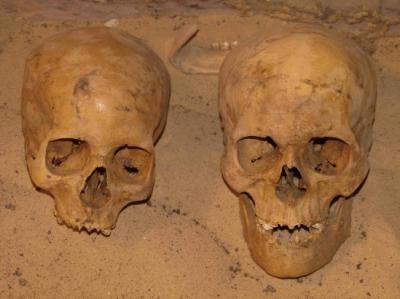In Hollywood period pieces, ancient Egypt is disturbingly western-looking actresses rolling out of carpets in magnificent palaces. The reality seems to be different, even for the elites.
Governors and commoners alike suffered from hunger and malnutrition, a whole range of infectious diseases and an extremely high infant mortality rate, according to the Qubbet el-Hawa research project carried out by the University of Jaen, in which anthropologists from the Supreme Council of Antiquities of the Arab Republic of Egypt and the University of Granada sought to separate truth from legend.
It involves excavating tomb no. 33 of the Qubbet el-Hawa necropolis, right opposite the modern-day city of Aswan, about 1000 km. south of Cairo. The tomb was constructed during the 12th Dynasty (1939-1760 BC), to house the corpse of one of the region of Aswan's leading dignitaries, whose identity is still unknown. The site was later re-used at least three times (18th, 22nd and 27th Dynasties), is one of the largest in the necropolis and has a huge archaeological potential, since it houses at least one chamber that remains intact, containing three decorated wooden sarcophagi.

The lefthand cranium belongs to an individual of average characteristics, almost Mediterranean (white). The cranium on the right is from a robust negroid individual, a Nubian of the time (approx. 1750 BC). Credit: University of Granada
Scholars have been taking part in field work to carry out the anthropological analysis of the bones of the mummies unearthed in the excavation, as well as calculating the number of individuals belonging to the more recent occupations of the tomb (New Kingdom, 3rd Intermediate Period and Late Dynastic Period). The researchers have found over 200 skeletons and mummies in tomb no. 33.
The initial results led them to draw interesting conclusions and have revealed new data not only about the ancient Egyptians physical characteristics, but also about the living conditions at that time. As Prof. Miguel Botella Lopez from the University of Granada's Laboratory of Physical Anthropology explains, "although the cultural level of the age was extraordinary, the anthropological analysis of the human remains reveals the population in general and the governors – the highest social class – lived in conditions in which their health was very precarious, on the edge of survival".
According to the anthropologists, life expectancy barely reached 30, "since they suffered from many problems of malnutrition and severe gastrointestinal disorders, due to drinking the polluted waters of the Nile". This is revealed by the fact that the bones of the children had no marks on them, "which demonstrates that they died from some serious infectious disease".
The researchers found a large number of mummies belonging to young adults of between 17 and 25 years old.
First mention of the pygmies
Miguel Botella points out that the tombs of the Qubbet el-Hawa necropolis contain inscriptions that are "of great historical importance, not only for Egypt, but for the whole of Humanity". In the tomb of Governor Herjuf (2200 BC), the inscriptions describe the three journeys he made to central Africa, during one of which he brought back a pygmy; this is supposedly the oldest mention made of this ethnic group.
Other inscriptions tell of Egypt's relations with the neighboring region of Nubia (present-day Sudan) over a period of almost 1000 years. Qubbet el-Hawa continues to be one of the most important archaeological sites in Egypt, not only fore discoveries already made, but also for the amount of information it contains about health and illness, and intercultural relations in ancient times.






Comments